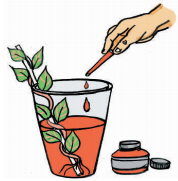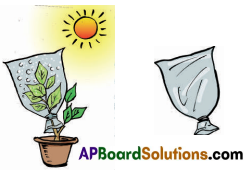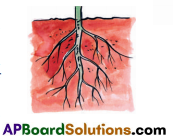These TS 6th Class Science Bits with Answers 9th Lesson Plants: Parts and Functions will help students to enhance their time management skills.
TS 6th Class Science Bits 9th Lesson Plants: Parts and Functions
Question 1.
The main root part of the plant ( )
A) Tap root
B) Fibrous root
C) Ciliated root
D) Fat root system
Answer:
A) Tap root
![]()
Question 2.
The roots present in grass ( )
A) Tap root
B) Fibrous roots
C) Fat root system
D) Trunk root
Answer:
B) Fibrous roots
Question 3.
Roots which store food ( )
A) storage roots
B) tuberous roots
C) hard roots
D) soft roots
Answer:
B) tuberous roots
Question 4.
One plant doesn’t possess tap root system ( )
A) Neem
B) Rice plant
C) Guava
D) Mango
Answer:
B) Rice plant
![]()
Question 5.
This helps in anchoring the plant body to the soil ( )
A) root
B) stem
C) branch
D) twig
Answer:
A) root
Question 6.
The number of root systems ( )
A) 2
B) 1
C) 4
D) 3
Answer:
A) 2
Question 7.
The minerals present in the soil are absorbed by ( )
A) Stem
B) Leaf
C) Root
D) Fruit
Answer:
C) Root
Question 8.
In some plants, food is stored in roots. These roots are called ….( )
A) Tap roots
B) Tuberous roots
C) Fibrous roots
D) None
Answer:
B) Tuberous roots
![]()
Question 9.
Example for Tuberous root ( )
A) Carrot
B) Raddish
C) Beetroot
D) All
Answer:
D) All
Question 10.
The stalk like structure of leaf : ( )
A) vein
B) midrib
C) palm
D) petiole
Answer:
D) petiole
Question 11.
…… acts as a skeleton of the leaf and gives it a shape and support ( )
A) Petiole
B) Stalk
C) Venation
D) Midrib
Answer:
C) Venation
Question 12.
The flat portion of the leaf ( )
A) Petiole
B) Edge
C) Midrib
D) Lamina
Answer:
D) Lamina
![]()
Question 13.
Which part connects leaf lamina with stem? ( )
A) Petiole
B) Midrib
C) Vein
D) Edge
Answer:
B) Midrib
Question 14.
The long vein present in the middle of the leaf is ( )
A) Midrib
B) Lamina
C) Vein
D) Petiole
Answer:
A) Midrib
Question 15.
Leaf prepares food by the process of ( )
A) Digestion
B) Photosynthesis
C) Respiration
D) Excretion
Answer:
B) Photosynthesis
Question 16.
Reticulate venation is present in the plants having the following root system. ( )
A) Tap Root system
B) Fibrous Root system
C) System of Rootlets
D) Adventitious root system
Answer:
A) Tap Root system
Question 17.
Carrot, sweet potato are good examples of …………. ( )
A) leaves
B) storage stem
C) tuberous roots
D) All
Answer:
C) tuberous roots
Question 18.
One of the following parts is not an aerial part of the plant. ( )
A) Leaves
B) Flower
C) Tuberous stem
D) Branch
Answer:
C) Tuberous stem
Question 19.
In a plant leaves and flowers grow from the ( )
A) branch
B) stem
C) roots
D) apex
Answer:
B) stem
![]()
Question 20.
Branches are absent in this plant ( )
A) Sugarcane
B) Tulasi
C) Hibiscus
D) Rose
Answer:
A) Sugarcane
Question 21.
We will see a on the stem of potato. ( )
A) root
B) blade
C) patch
D) scar
Answer:
D) scar
Question 22.
These attract insects for pollination ( )
A) flowers
B) fruits
C) seeds
D) leaves
Answer:
A) flowers
Question 23.
Potato is a modified. ( )
A) root
B) leaf
C) stem
D) seed
Answer:
C) stem
Question 24.
One of the following is not a modified stem ( )
A) Garlic
B) Carrot
C) Ginger
D) Potato
Answer:
B) Carrot
Question 25.
Colourful structures of the flower ( )
A) Sepals
B) Pollens
C) Buds
D) Petals
Answer:
D) Petals
Question 26.
Example for parallel leaf venation having plant is ( )
A) Mango
B) Neem
C) Jowar
D) Hibiscus
Answer:
C) Jowar
Question 27.
Banana oil is made from ……………. ( )
A) Bananas
B) Banyan tree
C) Petroleum
D) Banana plant
Answer:
C) Petroleum
![]()
Question 28.
Find the mis-matched pair … . ( )
i) Grass – parallel venation
ii) Mango – parallel venation
iii) Sugarcane – parallel venation
iv) Neem – reticulate venation
A) i
B) ii
C) iii
D) iv
Answer:
B) ii
Question 29.
Match the following. ( )
List-I — List-Il
1. Carrot — a) Stem
2. Potato — b) Fibrous roots
3. Grass — c) Tuberous roots
A) 1 – a, 2 – b, 3 – c
B) 1 – b, 2 – c, 3 – a
C) 1 – b, 2 – a, 3 – c
D) 1 – c, 2 – a, 3 – b
Answer:
D) 1 – c, 2 – a, 3 – b
Question 30.
Find the odd one out regarding types of plants and their nature ( )

Answer:
D.
Question 31.
Find the modified stems among the following ( )
i) Turmeric
ii) Beet root
iii) Radish
iv) Potato
v) Garlic
vi) Ginger
A) i, iv, v, iii
B) ii, iii & iv
C) i, iii, iv, v, vi
D) i, iv, v, vi
Answer:
C) i, iii, iv, v, vi
![]()
Question 32.
a) Stomata are bean shaped structures
b) They help in exchanging of food. Which is correct? ( )
A) Both a & b are correct
B) a is correct h is wrong
C) Both a & b are wrong
D) a is wrong h is correct
Answer:
B) a is correct h is wrong
Question 33.
a) The arrangement of veins in the lamina is called venation ( )
b) Venation acts like a skeleton of leaf.
A) Both a & b are wrong
B) a is wrong b is correct
C) a is correct b is wrong
D) Both a & b are correct
Answer:
D) Both a & b are correct
Question 34.
Scaly leaves are not present in ( )
A) Grass
B) Mango
C) Paddy
D) A or C
Answer:
B) Mango
![]()
Question 35.
1) Water is released from plant in the form of vapours.
2) Excess water is released from the plant through the stomata.
3) Transpiration helps in removal of excess water from plants.
A) all sentences are correct
B) sentence I is correct ( )
C) 2 & 3 are correct
D) All are wrong
Answer:
A) all sentences are correct
Question 36.
If leaves are absent in the mango tree, ( )
A) the plant won’t prepare water
B) the plant will die
C) photosynthesis decreases
D) respiration increases
Answer:
B) the plant will die
Question 37.
Why do leaves have stomata? ( )
A) To receive carbondioxide
B) To release oxygen
C) To prepare food
D) All the above
Answer:
D) All the above
Question 38.
………. carries the water absorbed by the roots to different parts of the plant ( )
A) root
B) leaf
C) branch
D) stem
Answer:
D) stem
Question 39.
If transpiration is not done in the plants ( )
A) the plants do not prepare food properly
B) the plants cannot maintain water percentage
C) water imbalance occurs in the plant
D) all the above
Answer:
D) all the above
Question 40.
The incorrect function of the leaf among the following statements.
A) Preparation of starch by photosynthesis ( )
B) Exchange of gases through stomata
C) Elimination of water vapour through transpiration
D) Restrict water transportation
Answer:
D) Restrict water transportation
![]()
Question 41.
What would happen if stomata are absent in leaves? ( )
A) Transpiration does not occur
B) No gas exchange occurs
C) Water transportation does not occur
D) All of the above
Answer:
D) All of the above
Question 42.
Leaf : Photosynthesis : : Root ………..
A) Food preparation
B) Water preparation
C) Taking water and minerals
D) Food releasing
Answer:
C) Taking water and minerals
Question 43.
Pistils have three parts. They are
A) stigma, ovule, style
B) ovary, seed, petal:
C) petiole, stigma, style
D) stigma, style, ovary
Answer:
D) stigma, style, ovary
Question 44.
Why don’t all the plants have the same kind of leaves?
A) Based on the place and conditions the leaves are modified
B) Based on the stem they grow roots
C) Roots develop leaves
D) Stem produces leaves
Answer:
A) Based on the place and conditions the leaves are modified
Question 45.
Choose the correct answer ( )
A) All roots are similar in paddy
B) Potato is a stern tuber
C) Grass has reticulate venation
D) Tamarind has fibrous root system
Answer:
A) All roots are similar in paddy
Question 46.
If you don’t know the name of a collected plant what would you do?
A) We will ask our teacher
B) We will ask the gardener ( )
C) We will ask the farmer
D) Above all
Answer:
D) Above all
![]()
Question 47.
What is the nature of the root system that you observed in Tridax plant.
A) Tap root system – main root with lateral roots ( )
B) Fibrous root system – main root with lateral roots
C) Tap root system — Root hairs
D) Lateral root system with tap roots
Answer:
A) Tap root system – main root with lateral roots ( )
Question 48.
What is the purpose of adding ink in the tumbler? ( )

A) In order to observe minerals and food that is absorbed by plant
B) In order to observe water and minerals absorbed by roots of plant
C) In order to cut the stem of a plant
D) In order to cut the leaves of a plant
Answer:
B) In order to observe water and minerals absorbed by roots of plant
Question 49.
What aspects are considered in observing the similarities among leaves of different plants? ( )
1. Leaf base, Petiole, Lamina
2. Leaf shape, Leaf edge
3. Leaf life, Place of leaf on stem
A) 1 and 3
B) 1 and 2
C) 2 and 3
D) 1,2 and 3
Answer:
B) 1 and 2
Question 50.
If you want to observe types of venation in leaves what leaves are to be collected? ( )
A) Mango and Grass
B) Grass and Paddy
C) Grass and Hvdrilla
D) Mango and Guava
Answer:
A) Mango and Grass
![]()
Question 51.
Write the steps involved in observing stomata in leaves ( )
1. Fleshy leaf is taken 2. Put a drop of water on it
3. Peel the outer layer of the leaf 4. Observe it under microscope
5. Place it on a slide.
A) 1, 2, 3, 4, 5
B) 5, 4, 3, 2, 1
C) 4, 5, 2, 3,1
D) 1, 3, 2, 5, 4
Answer:
D) 1, 3, 2, 5, 4
Question 52.
Where do we see traditional cottage industry where pictures of various mythological figures are drawn with bright colours on dried leaves ( )
A) Warangal
B) Mahaboob nagar
C) Khammam
D) None
Answer:
A) Warangal
Question 53.
Read the given lines.
Some plants store food in roots and stems. Some plants like radish, carrot,beetroot store food materials in their roots. What is the special feature in the plants like radish, carrot, beetroot etc?
A) Roots of these plants store water
B) Roots of these plants store food
C) Stem of these plants store food
D) Leaf of these plants store food
Answer:
B) Roots of these plants store food
Question 54.
| Neem | Reticulate venation |
| Grass | Parallel venation |
| Tulasi | Reticulate venation |
Based on the information studied by you what type of venation is seen in the plant Sapota? ( )
A) Parallel venation
B) Parallel venation or Reticulate venation
C) Reticulate venation
D) Horizontal venation
Answer:
C) Reticulate venation
![]()
Question 55.
Read the table
| Parthenium (Congress weed) | Tap root system |
| Paddy | Fibrous root system |
| Tridax | Tap root system |
What types of root system is seen in plants like grass or rice? ( )
A) Tap root system
B) Fibrous root system
C) Tap root it Fibrous root system
D) Upper tap root system
Answer:
B) Fibrous root system
Question 56.
Read the given lines.
There are variations in the size and shape of plants but generally all plants havel roots, stems and leaves.
What do plants generally have? ( )
A) Roots
B) Fruits & buds
C) Leaves & stem
D) All the above
Answer:
D) All the above
Question 57.
Read the given lines.
The long vein present in the middle of the leaf lamina is called midrib. The branches arising from the midrib are called veins. Veins in the leaf are very helpful in ? ( )
A) Giving shape and support
B) Supply material
C) A & B
D) Taking gases
Answer:
C) A & B
Question 58.
Venation of the leaf in the picture is? ( )

A) Reticulate
B) Parallel
C) Circular
D) Linear
Answer:
A) Reticulate
Question 59.
Find the type of venation. ( )

A) Reticulate venatiori
B) Parallel venation
C) Palmate venation
D) Pinnate venation
Answer:
B) Parallel venation
![]()
Question 60.
The following diagram represents ( )

A) Osmosis
B) Photosynthesis
C) Transpiration
D) Respiration
Answer:
C) Transpiration
Question 61.
The given picture of root system is present in ( )

A) Mango – Tap root system
B) Grass – Tap root system
C) Neem – Fibrous root system
D) Palm tree – Tap root system
Answer:
A) Mango – Tap root system
Question 62.
What is the use of given diagram present in plants? ( )

A) it is a stomata – for exchanging gases
B) It is a root – for exchanging food
C) It is a stomata – for transpiration
D) It is a leaf – for photosynthesis
Answer:
D) It is a leaf – for photosynthesis
Question 63.
……. helps in exchange of gases in trees ( )
A) Stem
B) Root
C) Stomata
D) Branch
Answer:
C) Stomata
Question 64.
We enjoy the beauty of nature through these components of plant?
A) Leaf
B) Flowers
C) Roots
D) Stem
Answer:
B) Flowers
Question 65.
How do plants help us? ( )
A) By giving food and air
B) By giving air and water
C) By cleaning environment
D) A and C
Answer:
D) A and C
Question 66.
Find the correct sentence on plants and their role in the nature. ( )
A) They give air to breathe
B) They make us to survive on the earth
C) Both
D) They confront our lives
Answer:
C) Both
Question 67.
Leaves expel excess water through the stomata. What do we call this process? ( )
A) Condensation
B) Melting
C) Evaporation
D) Transpiration
Answer:
D) Transpiration
![]()
Question 68.
Which of the following plant preserves food in the stem? ( )
A) Ginger
B) Carrot
C) Beetroot
D) Radish
Answer:
A) Ginger